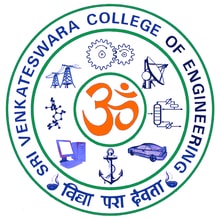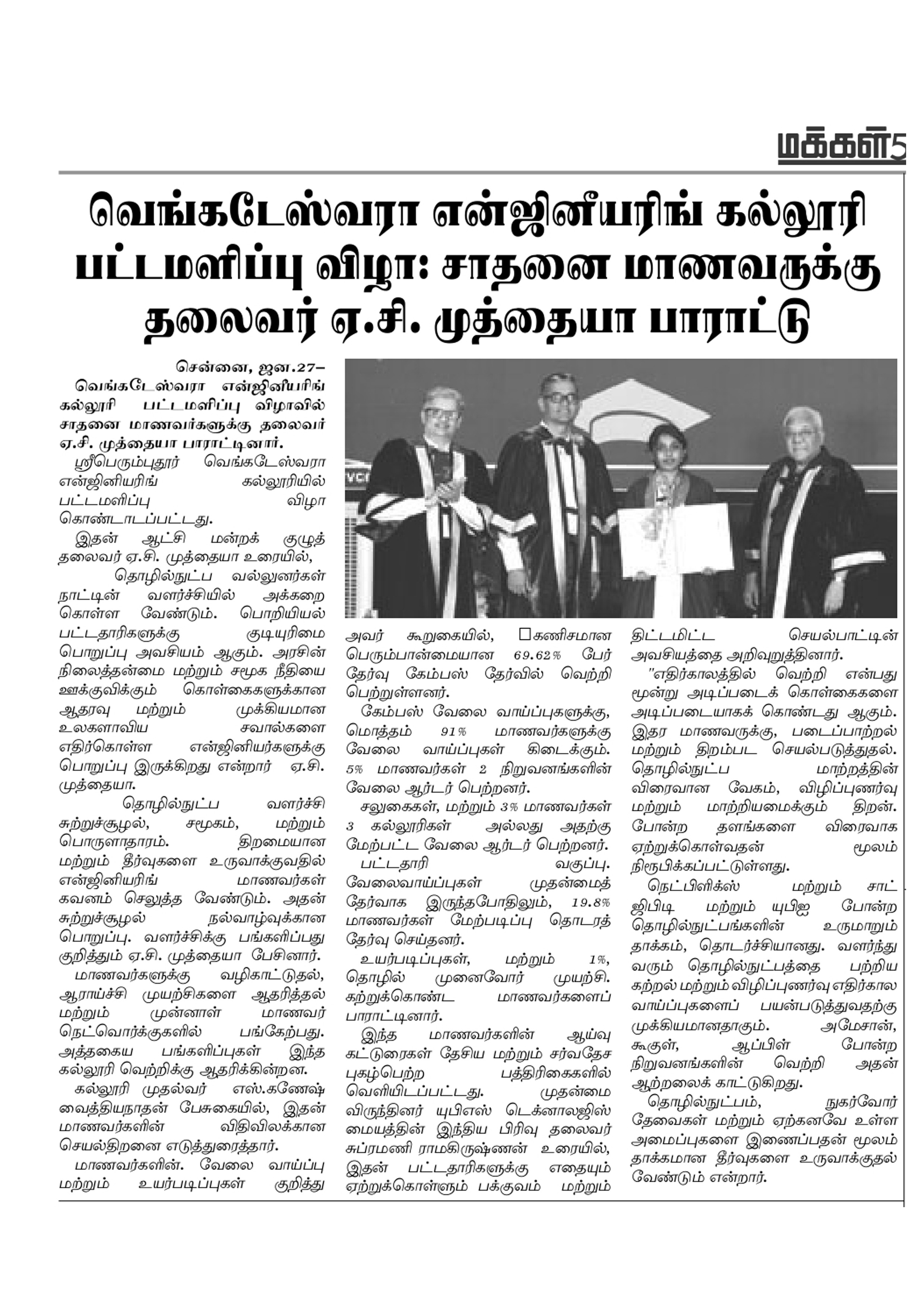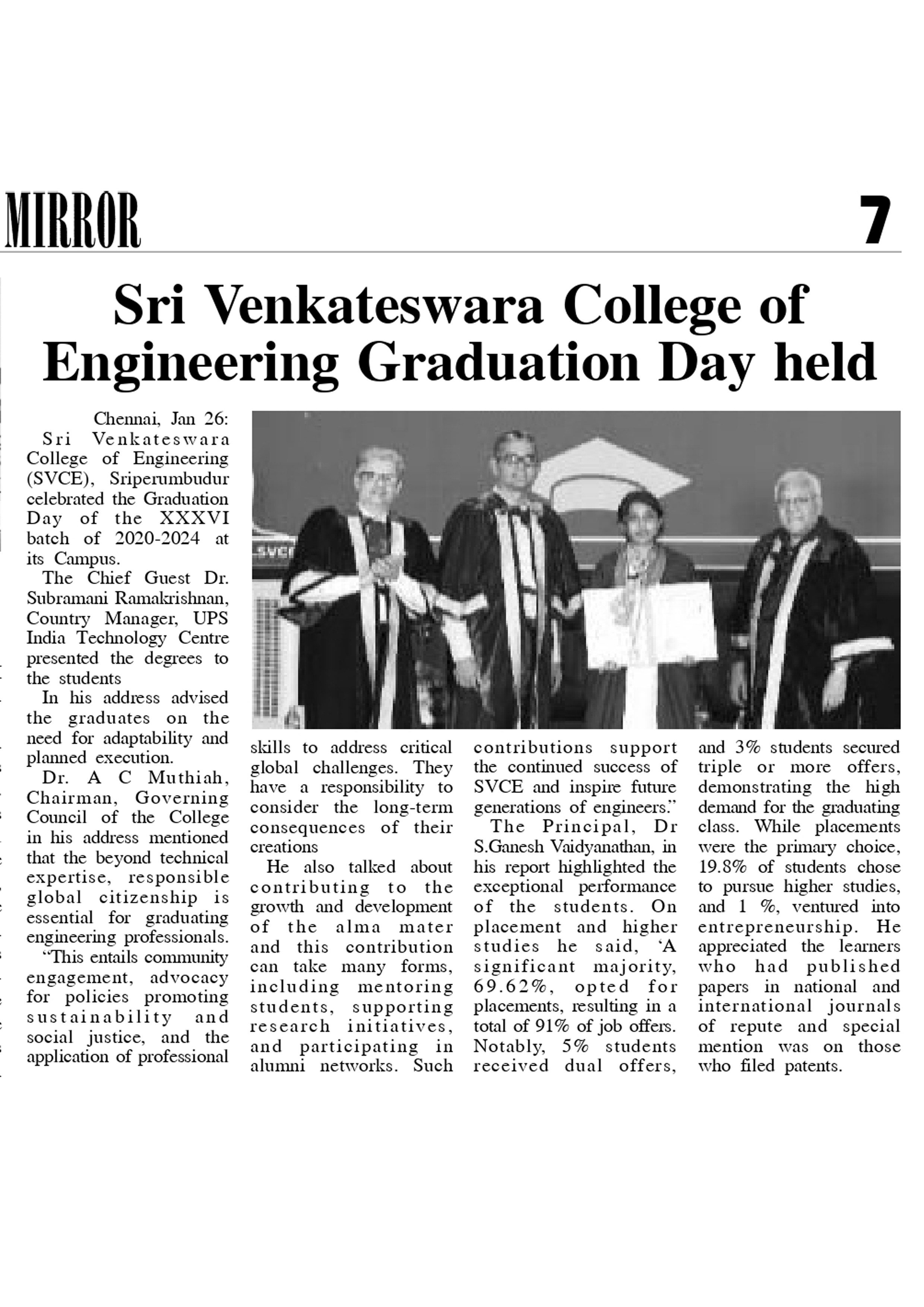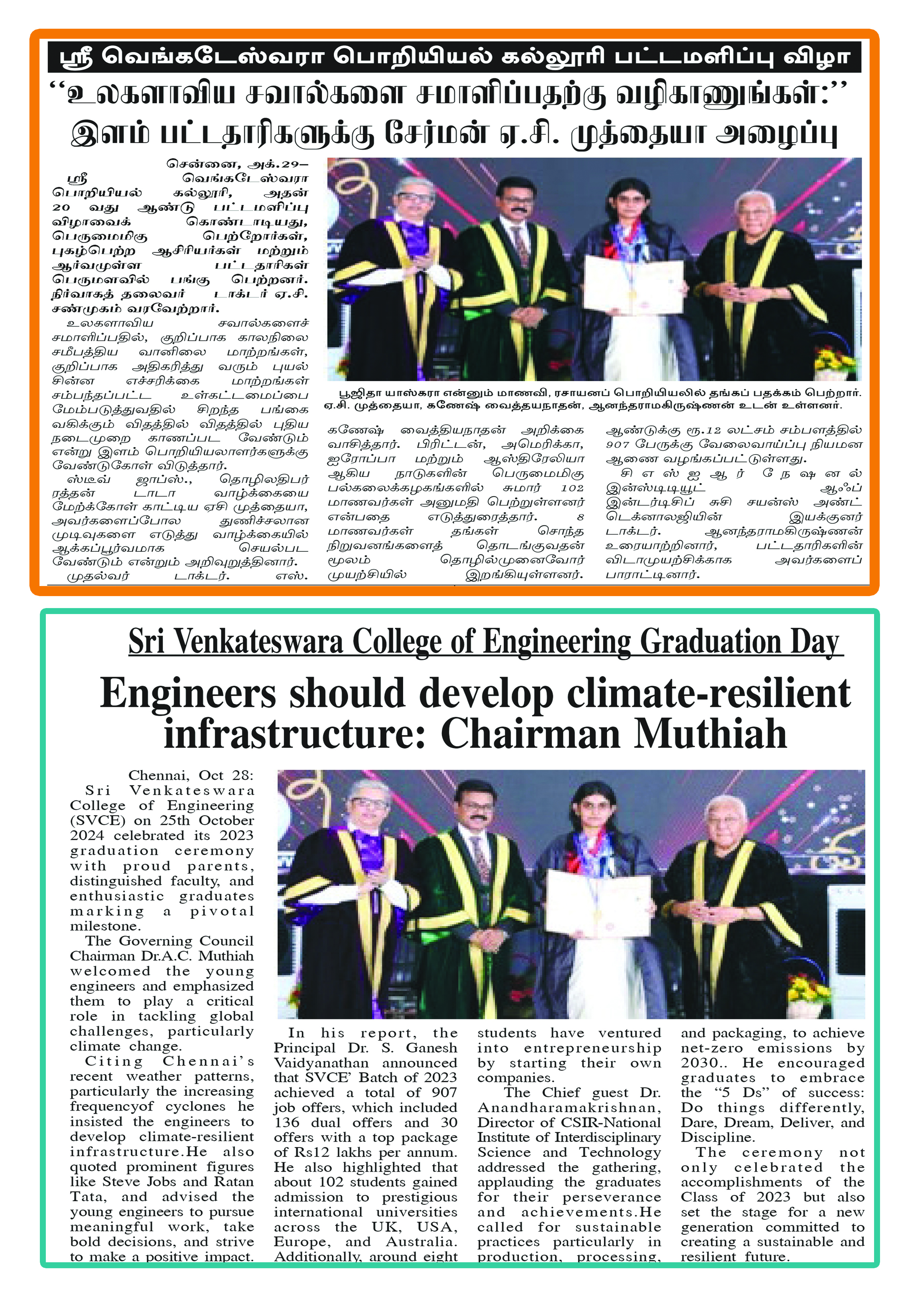OLD FLASH NEWS ARCHIVES
| Date | Title | Content | ||||||
|---|---|---|---|---|---|---|---|---|
|
28th - March - 2025
|
National Level 24 Hour MAKE-A-THON 6.0 Organized by Electronics and Communication Eng.
|
|||||||
|
28th - March - 2025
|
Transport arrangement for Parent Teacher Meet on 29/03/2025
|
|
||||||
|
28th - March - 2025
|
Transport arrangement for Parent Teacher Meet on 29/03/2025.
|
|
||||||
|
27th - March - 2025
|
TIChSCON'25: International Conference on Technological Innovations in Chemical Engineering.
|
|||||||
|
25th - March - 2025
|
Revised Circular for Formative Assessment Test II – UG Students(II, IV & VI Semesters)-2024-25 ES
|
|||||||
|
24th - March - 2025
|
Parent-Teachers Meeting (for both first-year and senior students) on 29th March 2025
|

|
||||||
|
13th - March - 2025
|
Invitation for Voluntary Blood Donation Camp - Phase-II on 15.03.2025
|
Warm Greetings!
The YRC, Rotaract Club, NSS, and RRC of SVCE cordially invite you to participate in the one-day Voluntary Blood Donation Camp on 15th March 2025 from 9:00 AM to 2:45 PM at Function Hall and Video Hall, SVCE.
We look forward to your support and participation in this noble cause.
Registration link for Blood donation : https://forms.gle/7NoWW9rUaU95qfjr8
Click here to view the Brochure:
|
||||||
|
10th - March - 2025
|
Inviting Nominations for Distinguished Alumni Award (2024-25).
|
Dear Alumni Community, We are excited to announce the call for nominations for the SVCE Distinguished Alumni Award. This prestigious award aims to recognize and celebrate the exceptional achievements and contributions of our alumni to their professions, communities, and society at large. To nominate a deserving candidate, please submit the information through the application attached. Please send your nominations to deansw@svce.ac.in on or before 21.03.2025. The selection committee will carefully review all nominations and select the recipient of the Outstanding Alumni Award. The award will be presented on College Day to be held on 04.04.2025. Thank you for your participation in recognizing the remarkable accomplishments of our alumni community. PRINCIPAL Click Here to Download the Application Form.(PDF) Click Here to Download the Application Form.(DOCX) |
||||||
|
8th - March - 2025
|
FAT – I Examination Schedule and Seating Arrangement for the First Year UG Students-2024-25 ES -reg
|
|||||||
|
2nd - March - 2025
|
Online Faculty Development Program Organized by the Department of Civil Engineering from 3rd to 7th March 2025.
|
|||||||
|
1st - March - 2025
|
FAT – I Schedule and Seating Arrangement for II and III year UG Students-2024-25(ES) -reg
|
|||||||
|
25th - February - 2025
|
Circular - Formative Assessment Test I – UG Students (IV & VI Semesters)-2024-25 ES
|
|||||||
|
25th - February - 2025
|
SVCE ORGANIZES Dr.A C MUTHIAH AND SVCE TOURNAMENT FROM 03RD TO 10TH MARCH 2025.
|
|||||||
|
18th - February - 2025
|
Revaluation Circular -2024 - 2025 ODD I Sem UG, I sem PG and backlog papers of all students
|
|||||||
|
18th - February - 2025
|
Pulse '25, A National Level Technical Symposium, February 22, 2025
|
Dear Sir/Madam,
Greetings from the Department of EEE, SVCE!
We are pleased to inform you that the Association of Electrical and Electronics Engineers (AEEE), Department of Electrical and Electronics Engineering, Sri Venkateswara College of Engineering is organising a National Level Technical Symposium PULSE '25 on 22nd February 2025.
Click here to view the Inaugural invite with Agenda
Click here to view the Event poster
|
||||||
|
18th - February - 2025
|
List of Final UG projects selected for SVCE Intramural grant for the AY 2024-2025.
|
|||||||
|
14th - February - 2025
|
The Three Massive Technical Events Coming up for Trackbot, Upagraha 25, and Make-a-thon 6.0
|
Department of ELECTRONICS AND COMMUNICATION ENGINEERING cordially invites students from all colleges, to our National level technical symposium UPAGRAHA ’25. The event will be conducted on 22nd February 2025. Check our website for more details. Don’t miss this opportunity. Website link:https://upagraha-25.vercel.app Click here to more details:Department of ELECTRONICS AND COMMUNICATION ENGINEERING in association with the INSTITUTION OF ELECTRONICS AND TELECOMMUNICATION ENGINEERS-STUDENTS’ FORUM along with IETE-CHENNAI CENTRE cordially invites students from all colleges, to our Intercollegiate Technical Event “ TRACKBOT”. This event will be conducted on 15th February 2025. Fill in the G-Form for registration. Don’t miss this opportunity. G-Form LINK: https://forms.gle/kw5nT6GFe6vSznE17 Click here to more details: |
||||||
|
14th - February - 2025
|
Anna University Sponsored FDTP on the EE3033 - Hybrid Energy Technology.
|
We are happy to inform you that the Department of Electrical & Electronics Engineering and Center for Integrated Smart Waste Management is organizing an Anna University Sponsored FDTP on the "EE3033 - Hybrid Energy Technology” from 17th Feb 2025 to 22nd Feb 2025. Click here to the Registration link: https://forms.gle/5EoqSkVqs61hRBoD8 Click here to the more details |
||||||
|
13th - February - 2025
|
The Engineers Without Borders SVCE Student Chapter is organizing a 3-day workshop.
|
The Engineers Without Borders SVCE Student chapter is organizing a 3-days Workshop on Drone Technology in collaboration with Aeroin SpaceTech Pvt Ltd.from 13th to 15th February 2025 (9:30 am to 3:15pm). Click here to view the details |
||||||
|
12th - February - 2025
|
AICTE feedback - Web portal link for Students and Faculty
|
As per the AICTE's directions, the web portal link for the Students and Faculty feedback is made available through the college website.
Click here to open the Feedback web portal
|
||||||
|
31st - January - 2025
|
SRF fellowship awarded to three Full time Research Scholars
|
|||||||
|
30th - January - 2025
|
Newspaper Clippings for Graduation day Class of 2024.
|
|||||||
|
28th - January - 2025
|
MATLAB and Simulink - Campus-wide license - Installation procedure
|
We are pleased to announce that Sri Venkateswara College of Engineering has successfully renewed the campus-wide license for MATLAB and Simulink, including all add-on products. This renewal ensures that the academic community of Sri Venkateswara College of Engineering has full access to these powerful tools for instruction, research, and personal projects.
MATLAB and Simulink -Campus-wide license - installation. Click here to view further details
Important: To maintain uninterrupted access to MATLAB and Simulink, individuals currently using MATLAB Campus License must update their license information.
Please follow the instructions below:
1. Ensure that your computer is connected to the internet.
2. Launch MATLAB.
3. If you encounter a license expiration error, please close MATLAB and then reopen it.
4. You may be prompted to sign in with your MathWorks account.
Should the users continue to experience problems, feel free to contact MathWorks Support at this Link:
Click here to view the Contact Support
|
||||||
|
24th - January - 2025
|
Transport arrangement for GRADUATION DAY 2025-(25.01.2025)
|
|
||||||
|
20th - January - 2025
|
Revaluation Circular -2024 - 2025 ODD semester of III, V and VII Sem UG and III sem PG students
|
|||||||
|
9th - January - 2025
|
Graduation Day for 2024 Passed-out Students of UG, PG and Ph.D. Programs on 25.01.2025
|
Dear Alumni,
PRINCIPAL |
||||||
|
31st - December - 2024
|
SRF fellowship awarded to three Full time Research Scholars
|
|||||||
|
28th - December - 2024
|
Hindu Tamizh article published 28/12/2024 - AICTE sponsored ATAL FDP
|
An article has been published in Hindu Tamizh dated 28/12/24 showcasing AICTE sponsored ATAL FDP on "Advanced Semiconductor Devices and AI Chips - Research Opportunities and Challenges" organized by SVCE. Click here to view the News Article |
||||||
|
27th - December - 2024
|
Invitation to the SATY Summer Camp 2025 at SVCE
|
Greetings from SVCE! We are pleased to inform you that Springboards, Chennai, and Sri Venkateswara College of Engineering (SVCE), in association with AIMST University, Malaysia, are organizing the 7th Summer Camp on "Engineering & Technology for School Children" (SATY 2025). The camp is scheduled to be held from 5th to 9th May 2025 for school students from classes 8 to 12. A brochure and registration form for the event are attached for your reference. 👉Click here to view the Brochure and Registration Form |
||||||
|
24th - December - 2024
|
DECEMBER - 2024 - End Semester Examination Schedule - PHASE II
|
The schedule for the Summative Examinations of December 2024, Phase II, for the following semesters is as follows: 1. R22 - UG - I semester subjects 2. R22 - PG - I semester subjects 👉Click here to view the schedule |
||||||
|
23rd - December - 2024
|
FAT – III Schedule and Seating Arrangement for the First Year UG Students-24OS -reg
|
|||||||
|
2nd - December - 2024
|
FAT-II Rescheduled Circular (UG, First-Year, I Semester) - 24OS
|
Reschedule of FAT-II UG First-Year-24 OS
To view the Reschedule(click here) |
||||||
|
30th - November - 2024
|
Notification-II - Reschedule of End semester Theory Examinations fixed on 30/11/2024
|
Reschedule of End semester Theory Examinations fixed on 30/11/2024
To view the Reschedule of End semester Theory Examinations fixed on 30/11/2024(click here) |
||||||
|
29th - November - 2024
|
College will be closed tomorrow (30/11/2024) due to the inclement weather forecast declared by Govt of Tamilnadu
|
College will be closed tomorrow (30/11/2024) due to the inclement weather forecast declared by Govt of Tamilnadu
Also, the examinations scheduled on 30/11/2024 are cancelled and will be conducted later. The rescheduled date will be intimated by the COE.
PRINCIPAL
|
||||||
|
25th - November - 2024
|
FAT – II Schedule and Seating Arrangement for the First Year UG Students-24OS -reg
|
Click here to view the FAT schedule(click here) Click here to view the FAT seating arrangement(click here) |
||||||
|
22nd - November - 2024
|
CoE_Notification I for 2024-2025 Odd Semester Students.
|
Click here to view the information(click here) |
||||||
|
22nd - November - 2024
|
List of final year PG projects selected for Intramural funding -Academic Year(2024-2025)
|
To view the PG intramural funding-Academic Year(2024-2025)(click here) |
||||||
|
21st - November - 2024
|
Transport Arrangement for Parent Teacher Meeting
|
Click here to view the transport schedule(click here) |
||||||
|
15th - November - 2024
|
Parent-Teacher Meeting – for first year Students - 23rd November 2024 (Saturday) -Reg.
|
Click here to view the program schedule(click here) |
||||||
|
13th - November - 2024
|
Six Days ATAL Online FDP on IoT in Healthcare: Transforming Patient Care and Management
|
The Department of Electronics and Communication Engineering is organizing a six-day online Faculty Development Programme (FDP), under AICTE Training and Learning FDP Program, during the period December 09 to December 14, 2024. We invite interested faculty members to register for this valuable opportunity to enhance their skills and knowledge. 👉Registration link: https://atalacademy.aicte-india.org/login 👉ATAL_FDP_Schedule: Click to view 👉Brochure_ATAL_FDP_SVCE link: Click to view 👉NOC Format link: Click to Download |
||||||
|
10th - November - 2024
|
AICTE sponsored One - Week Faculty Development Programme under AICTE Training and Learning FDP Program
|
The Department of Electrical and Electronics Engineering is organizing a one-week Faculty Development Programme, sponsored by AICTE, under the AICTE Training and Learning (ATAL) FDP program, from December 16 to 21, 2024 Interested faculty members may register for the FDP Objectives of the FDP: 1. Expert talks from Industry and Academia - Semiconductor technology and manufacturing. 2. Hands-on training in cleanroom - DST FIST sponsored Nano Research Centre. 3. Explore Research opportunities - Smart materials and Nanoscale devices. 4. Possibilities of Start-up through innovation - IC fabrication and product development.👉Registration link: https://atalacademy.aicte-india.org/login 👉ATAL_FDP_Flyer link: Click to view 👉Brochure_ATAL_FDP_SVCE link: Click to view 👉NOC Format link: Click to Download |
||||||
|
8th - November - 2024
|
FAT – III Schedule and Seating Arrangement for II, III and IV Year UG Students-24OS -reg
|
Dear Student, click here to view the schedule and seating arrangement for the Formative Assessment Test-III for II, III, and IV-year UG students for the academic year 2024-2025 (Odd Semester). 👉FAT–III Schedule👉FAT–III Seating Arrangement |
||||||
|
29th - October - 2024
|
College Graduation Day Class of 2023 News Clippings
|
|||||||
|
25th - October - 2024
|
Graduation Day for 2023 Passed-out Students of UG, PG and Ph.D. Programs on 21.09.2024
|
Dear Alumni,
We are happy to inform you that the college is planning to conduct the Graduation Ceremony for 2023 Passed-out students of UG, PG and Ph.D. programs on Saturday, September 21, 2024.
Kindly upload the acceptance form and submit the hard copy of the same in person to the respective department on September 21, 2024.
Kindly note that the function will be held on our College campus at the “His Holiness Sri Jayendra Saraswathi Platinum Jubilee Complex Multipurpose Hall”.
Registration will start at 8:40 am. All the graduands are required to be present for the rehearsal at 10.30 am at the venue.
The detailed schedule of the programme will be uploaded shortly on the website.
Please submit your willingness on or before September 17, 2024, by 10.00 am using the following link.
https://docs.google.com/forms/d/1OIFtengGzlqqYGXp7Uq4EAPHgfQVEemmo08ir8cUWas/edit
Strictly the deadline will not be extended.
Graduation Day September 2024 - Acceptance Form
PRINCIPAL
|
||||||
|
24th - October - 2024
|
Transport arrangement for GRADUATION DAY 2024
|
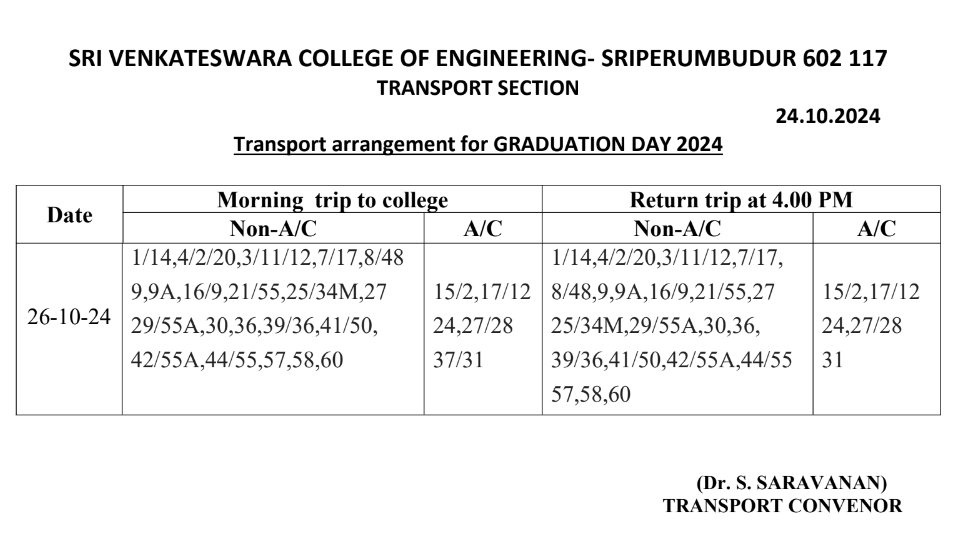 |
||||||
|
19th - October - 2024
|
FAT – I Schedule and Seating Arrangement for the First Year UG Students-24OS -reg
|
|||||||
|
17th - October - 2024
|
SVCE Intramural Research grant 2024-2025 - selected Projects
|
|||||||
|
15th - October - 2024
|
Holiday declared on 16.10.24, Wednesday
|
TN Government has declared holiday on 16th October 2024, Wednesday due
to heavy rain forecast by IMD. As per the directions from the Secretary
holiday is declared for the college on 16th October 2024.
VICE PRINCIPAL
|
||||||
|
14th - October - 2024
|
Holiday Declared on 15th Oct 2024 by TN Govt
|
TN Government has declared holiday on 15th Oct 2024, Tuesday due
to heavy rain forecast by IMD. As per the directions from the Secretary
and Vice Principal, holiday is declared for the college on 15th Oct 2024.
College buses will leave the campus as usual today.
HR
|
||||||
|
3rd - October - 2024
|
National level 24 hours CHEMINNOTHON’24
|
With immense pleasure and pride the Department of Chemical Engineering,SVCE is pleased to announce a National level, interdisciplinary 24 hours Hackathon named as CHEMINNOTHON’24 resulting from the vision of IIChE- SVCE and AIChE- SVCE students' chapters to bring students together from various streams of Engineering and culminating under one roof for the next generation of innovations in Chemical and Allied Engineering.
Venue: Multipurpose Hall, SVCE
Dates: 18th & 19th October, 2024
|
||||||
|
3rd - October - 2024
|
Graduation Day for 2023 Passed-out Students of UG, PG and Ph.D. Programs on 26.10.2024
|
Dear Alumni,
👉Graduation Day 2024 Invitation 👉Click here to give your willingness for the Graduation day participation |
||||||
|
30th - September - 2024
|
Invitation for Voluntary Blood Donation Camp OS-2024 on 01.10.2024
|
The Rotaract Club, YRC, NSS and RRC of SVCE cordially invite you all for the one-day Voluntary Blood Donation Camp* on 01st October, 2024 (9:00 am - 2:30 pm) on the occasion of celebration of National Voluntary Blood donors day at Multi Purpose Hall(MPH), SVCE 👉 click Here the Registration link for Blood donation : *Blood Donors Slot: IV Year: 09.30 am to 12.30 pm III Year: 10.30 am to 01.30 pm II Year: 11.30 am to 02.30 pm |
||||||
|
27th - September - 2024
|
FAT – II Schedule and Seating Arrangement for II, III and IV Year UG Students-24OS -reg
|
The below link of Formative Assessment Test details |
||||||
|
26th - September - 2024
|
SVCE has migrated to ISO 21001:2018
|
SVCE has migrated to ISO 21001:2018, Educational Organizations Management System (EOMS), and obtained a certificate in August 2024. |
||||||
|
25th - September - 2024
|
Applications are invited for the enrolment of Registered members of YRC-SVCE Unit
|
Dear Students, Applications are invited for the enrolment of registered members of YRC-SVCE Unit from first year students of SVCE(2024 Admitted). Interested students are requested to submit their request thro the Google form attached herewith on or before 30.09.2024. |
||||||
|
24th - September - 2024
|
Circular - Formative Assessment Test II – UG Students (III, V, VII Semesters)-24OS
|
The below link of Formative Assessment Test details |
||||||
|
19th - September - 2024
|
MSME Idea Hackathon 4.0
|
Ministry of MSME has launched “MSME Idea Hackathon 4.0” on 11.09.2024 by Hon'ble Minister of MSME. Ideas are being invited under MSME Idea Hackathon 4.0 from Youngsters aged between 18-35 from all over India under MSME Innovative Scheme. MSME Idea Hackathon 4.0 is live at https://my.msme.gov.in/inc/ & the portal will be open till 26.09.2024. 👉 Instructions to shortlist Ideas received under MSME Idea Hackathon 4.0 by Host Institutes (HIs) |
||||||
|
19th - September - 2024
|
Seeds and Wings Scholarship Distribution Ceremony
|
|||||||
|
13th - September - 2024
|
NSO Activities Registration link for the first year students
|
The below link of NSO Activities Registration for the first year students |
||||||
|
13th - September - 2024
|
Transport arrangement for parent teacher meet on 14.09.24
|
The transport arrangements route No:[1/14,3/11/12,4/2/20,7/17 ,9A,16/10,21,27/29,31/37,36,39/30,44,56,58,60] |
||||||
|
10th - September - 2024
|
NSS Volunteers enrollment form for First-Year Students
|
The NSS unit of SVCE invites first-year students to join and participate in community service activities through NSS. Interested first-year students are encouraged to fill out the Google form. |
||||||
|
3rd - September - 2024
|
SIP 2024 - Detailed Programme Schedule
|
|||||||
|
2nd - September - 2024
|
TRANSPORT ARRANGEMENT FOR INDUCTION PROGRAMME FOR FIRST YEAR-[04/09/2024]
|
|||||||
|
31st - August - 2024
|
Parent-Teacher Meeting – for Senior Students -Saturday, September 14 2024 -Reg.
|
|||||||
|
30th - August - 2024
|
HACKELITE 24 Hours - Hackathon on 30 & 31 August, 2024
|
|||||||
|
29th - August - 2024
|
A 24-Hours Hackathon -"HACKELITE" - will be conducted by ECE Dept during 30-31 August 2024
|
The Department of ECE is organising a 24-Hours Hackathon -"HACKELITE", with the support of ECE Alumni members.The event is scheduled on 30th and 31st August 2024 (Friday and Saturday).
We invite you for the Inaugural ceremony on 30th of August 2024, 09:00 A.M and the valedictory ceremony on 31st August 2024, 9:30 AM at Dr.A.C.Muthiah Central Library Seminar Hall - SVCE
Click here to view the Invitation
Click here to view the Hacklitre Flyer
|
||||||
|
22nd - August - 2024
|
First Year B.E./B.Tech. classes will commence on 04/09/2024(Wednesday)
|
The First Year B.E./B.Tech. classes will commence on 04/09/2024(Wednesday) with the Inaguration of Induction Programme.
Click to view the Student Inaguration Schedule Details
|
||||||
|
22nd - August - 2024
|
Student Induction Programme 2024 - Inauguration Schedule
|
|||||||
|
22nd - August - 2024
|
|
|||||||
|
16th - August - 2024
|
FAT – I (II, III and IV Year UG Students) schedule and seating Arrangement
|
|||||||
|
31st - July - 2024
|
Dr. MAC Inter School Cricket Tournament 2024 Registration
|
Click the Rules & Regulation Details Registration Link : Click the Registration. |
||||||
|
29th - July - 2024
|
April/May 2024 Examinations - Provisional Certificate
|
|
||||||
|
29th - July - 2024
|
B.E/B.Tech. UG – Lateral Entry Students’ Admission – Instructions to TNEA 2024 allotted students
|
|||||||
|
24th - July - 2024
|
Availability of Fabrication and Testing Facilities for Planar Microwave Components
|
|||||||
|
23rd - July - 2024
|
B.E/B.Tech. UG - First year Students' Admission - Instructions to TNEA 2024 allotted students
|
|||||||
|
23rd - July - 2024
|
Nominations are invited from interested registered members of YRC-SVCE
|
Nominations are invited from interested registered members of YRC-SVCE Unit for the selection of office bearers of YRC-SVCE Unit for AY 2024-'25 on or before 24.07.24, 4.30pm. |
||||||
|
8th - July - 2024
|
Commencement of classes for the academic year 2024-25 Odd Semester
|
Dear Students, Greetings!!! Classes for the academic year 2024-25 (Odd Semester) will commence from 10th July 2024. |
||||||
|
5th - July - 2024
|
Awardees of Alumni Scholarship from 1985-89 Batch – for the Academic Year 2024-25
|
"Greetings!!! The SVCE Alumni from the 1985-89 batch have been sponsoring the tuition fees for a group of Girl students from their Second year to Final year based on their financial need and good academic performance in the first year of study, to enable them to carry out their studies without worrying about the financial requirements. Awardees are also supported beyond the classroom by arranging internships and even providing them with job opportunities, if found suitable. Congratulations to Ms. Kirthika A, III-Year CS, Ms. Prathika P R, III-Year AD, Ms. Swetha S, III-Year EC, Ms. Aarthi A, III-Year IT, Ms.Harini A, II-Year CE, Ms.Janani E, II-Year CS, Ms.Viswasree S, II-Year EE, Ms.Yuvasri A, II-Year EC, Ms.Monika S, II-Year IT, and Ms.Pooja S, II-Year ME for being the seventh batch of students to avail the scholarship instituted by the SVCE 1985-89 batch. |
||||||
|
3rd - July - 2024
|
Academic schedule for III, V and VII SEM UG and III SEM PG - 2024-2025 Odd semester (Revision 01)
|
|||||||
|
15th - June - 2024
|
B.E- Marine Lateral Entry Admission(2024-25) - Enquiry Form
|
Greetings!!!
Department of Marine Engineering invites application for the B.E- Marine Lateral Entry Admission of the year 2024-25.
For further information on the course, Please click on this link to fill your contact details
|
||||||
|
3rd - June - 2024
|
B.E. MARINE ENGINEERING for Diploma Students (Lateral Entry Stream)
|
|||||||
|
23rd - April - 2024
|
Fee Circular 2024-25
|
Fee Circular 2024-25
Click To download the Fee Circular 2024-25
|
||||||
|
12th - February - 2024
|
Admission Brochure for M.E. Communication Systems programme for the AY 2024-2025
|
The Department of Electronics and Communication Engineering is inviting applications for Admission to M.E. Communication Systems programme for the AY 2024-2025. Click the Admission Brochure |
||||||
|
30th - October - 2023
|
Information Brochure for Admission to M.Tech Biotechnology for the Academic Year 2024-2025
|
|||||||
|
15th - June - 2023
|
Dress Code for Students
|
Dress Code for all the Students
Click here to view the Circular for the Dress code of all the Students
|
||||||
|
12th - April - 2021
|
SVCE MATLAB Campus-Wide License: Portal links and Installation details
|
Please find the attached MATLAB Installation Guide, MATLAB CWL Poster and other Materials.
Please find below details to learn about individual access to MATLAB and Simulink.
SVCE MATLAB Portal link : https://in.mathworks.com/academia/tah-portal/sri-venkateswara-college-of-engineering-31493209.html
The following links provide materials to assist with rollout to faculty and students in Sri Venkateswara College of Engineering :
|
||||||
|
4th - December - 2020
|
SVCE - Draft Standard Operating Procedures and Cleaning Guidelines to prevent COVID-19 & Instructions to the Visitors
|
|||||||
|
28th - May - 2020
|
AICTE Schemes for the all-round development of students
|
Dear Students,
All India Council for Technical Education has announced various schemes for the all-round development of students studying in AICTE approved institutions. Following are the four schemes being handled by Student Development Cell, AICTE.
1. Post Graduate Scholarship Scheme for full-time GATE/ GPAT qualified students admitted to M.E./ M.Tech. & M. Pharma courses in AICTE approved Institutions.
Click here to view the Post Graduate Scholarship Scheme poster
2. Pragati Scholarship/ Contingency awarded to meritorious Girls taking admission in AICTE approved technical institution at Degree/ Diploma.
Click here to view the Pragati Scholarship poster
3. Saksham Scholarship/ Contingency awarded to Differently-abled students taking admission to AICTE approved technical institution at Degree/ Diploma. Click here to view the Saksham Scholarship poster
4. Support Students for Participating in Competition Abroad (SSPCA).
Click here to view the poster for Participating in Competition Abroad (SSPCA)
You are requested to explore the possibility of getting the benefit out of these schemes.
|

